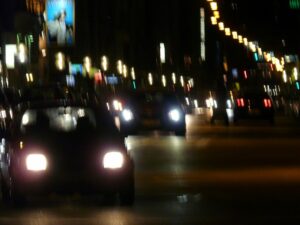Winter can be tough, and not just because of colder temperatures or threats of snow and ice. The longer hours of darkness in both the mornings and evenings can be challenging for many people when it comes to seeing well while driving. 
While we may have thought nothing of heading to an event or a restaurant at 6:30 or so when it’s perfectly light out in the summer, it’s a different matter in the winter with darkness settling in by that time.
For many of us, driving at night gets harder as we age. It’s just a fact of growing older that our night vision worsens because we have fewer rods—those light-sensitive cells in our eyes that distinguish between light and dark—that help us to see objects in low light.
Plus, our eyes’ lenses become stiffer and cloudier as we age, which reduces the amount of light entering our eyes as well as the sharpness of our vision. In addition, common conditions such as astigmatism can affect peripheral vision and depth perception, which makes it harder to see well at night.
Aside from normal changes in our eyes as we age or common conditions like astigmatism, other conditions like cataracts, macular degeneration, or glaucoma make it more difficult to see at night and drive safely as well.
Regardless of the underlying cause, it may be difficult—if not downright dangerous—to drive at night if you notice any of the following:
- Seeing halos around lights
- Increased glare from lights
- Blurry vision
- Dimmed or cloudy vision
- Reduced peripheral vision
- Eye fatigue
- Squinting in order to focus
If you notice even the slightest degree of limitations or changes to your vision while driving at night, please realize that the dangers of night driving are very real and should be taken seriously. This is important not only for your and your passengers’ safety, but for the safety of others who are on the road as well.
Fortunately, no matter what changes or difficulties you’re experiencing with your vision there are usually easy ways to correct your eyesight so that you’re seeing clearly and driving safely at night.
Often times, for those with mild difficulties driving at night, all that’s needed is a simple adjustment to a glasses prescription. For others with moderate night driving challenges, prescription night driving glasses can greatly reduce problems with glare and light sensitivity.
The important thing to know is that you shouldn’t suffer through the winter’s longer hours of darkness and put yourself at risk on the road. Your optometrist is there to help in exactly these kind of scenarios, so schedule an eye appointment to address the problem.
Hardin Valley Eyecare & Optical in Knoxville offers a variety of options for maintaining your optimal eyesight. Dr. Travis Thompson can recommend the best solutions for you based on a complete eye examination and a discussion of your vision needs both at work and in leisure, including driving at night. Be sure you bring any questions or concerns that you may have about driving at night with you when you come, and we’ll be glad to help
Since 2009, Hardin Valley Eyecare & Optical has provided the highest quality vision care products and trusted optometry services to our patients in Knoxville and the surrounding areas. Our eye care professionals are dedicated to providing exceptional personal service to everyone who walks through our door. Call us at (865) 409-1253 or contact us to schedule an appointment.





